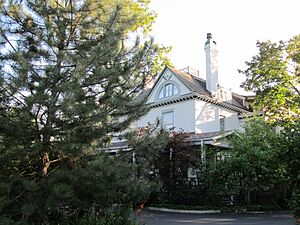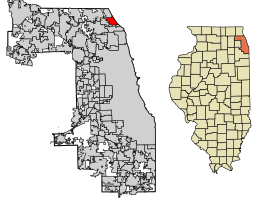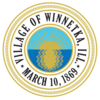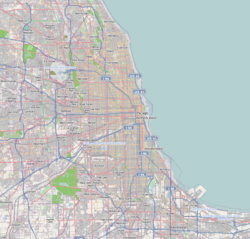Winnetka, Illinois facts for kids
Quick facts for kids
Winnetka, Illinois
|
|||
|---|---|---|---|
|
Village
|
|||

|
|||
|
|||

Location of Winnetka in Cook County, Illinois
|
|||
| Country | United States | ||
| State | Illinois | ||
| County | Cook | ||
| Township | New Trier | ||
| Incorporated | 1869 | ||
| Government | |||
| • Type | Council-manager | ||
| Area | |||
| • Total | 3.89 sq mi (10.08 km2) | ||
| • Land | 3.81 sq mi (9.87 km2) | ||
| • Water | 0.08 sq mi (0.21 km2) 2.06% | ||
| Elevation | 650 ft (200 m) | ||
| Population
(2020)
|
|||
| • Total | 12,475 | ||
| • Density | 3,344.00/sq mi (1,290.96/km2) | ||
| Down 1.87% from 2000 | |||
| Standard of living (2015–2019) | |||
| • Per capita income | $123,319 | ||
| • Median value of owner-occupied housing units | $1,091,700 | ||
| Time zone | Central | ||
| ZIP code(s) |
60093
|
||
| Area code(s) | 847 and 224 | ||
| Geocode | 82530 | ||
| FIPS code | 17-82530 | ||
Winnetka is a village located in Cook County, Illinois, United States. It is about 16 miles north of downtown Chicago. In 2020, about 12,475 people lived there. Winnetka is known as one of the wealthiest places in the United States. Its median household income was over $250,000 in 2022.
Contents
History of Winnetka
The first houses in Winnetka were built in 1836. A family from Vermont, Erastus Patterson and his family, opened a tavern. This tavern served travelers on the Green Bay Trail. In 1854, Charles Peck and Walter S. Gurnee officially divided the village into lots. Gurnee was the president of the Chicago, Milwaukee & St. Paul Railroad.
Winnetka's first private school opened in 1856 with 17 students. It was started by Mr. and Mrs. Charles Peck. In 1859, the first public school building was built. It was located at Elm and Maple streets. The budget for this school's first year was $200. The village officially became a town in 1869. At that time, about 450 people lived there. The name "Winnetka" is thought to come from the Potawatomi language. It means 'beautiful place'.
The oldest house still standing in Winnetka is the Schmidt-Burnham Log House. It was first built on what is now the Indian Hill Club. In 1917, it was moved to Tower Road. Then, in 2003, it was moved again to the Crow Island Woods.
Many famous architects designed homes in Winnetka. These include George Washington Maher and Walter Burley Griffin. Some famous people from Winnetka are actor Rock Hudson and musician Richard Marx. Churches in Winnetka were also designed by well-known architects. For example, the former First Church of Christ, Scientist, was designed by Solon S. Beman in 1924.
In the 1920s, a house was built at 671 Lincoln Avenue. This house became famous as the Home Alone house. Its outside was used for filming two movies in the Home Alone series, starting in 1990.
Transportation History
The Chicago and Milwaukee Railway was built through Winnetka in 1855. This railway connected Chicago and Milwaukee. It later became the Chicago and North Western Transportation Company. Between 1937 and 1942, the train tracks in Winnetka were changed. They were separated from the roads to prevent accidents. In 1995, the Chicago & Northwestern Railway joined with Union Pacific. Now, only Metra trains use these tracks. Freight trains stopped running in the late 1980s. Winnetka has three Metra stations: Hubbard Woods, Winnetka, and Indian Hill.
An electric train line, the Chicago, North Shore and Milwaukee interurban, was built through Winnetka in the early 1900s. This line was removed in 1955. Now, this path is the Green Bay Trail, which is used for bicycles.
Parks and Schools
The Winnetka Park District was created in 1904. It is the fourth oldest park district in Illinois. Today, it takes care of 27 parks and five beaches. It also has facilities for golf, tennis, ice skating, and paddle tennis.
The Crow Island School was designed by Eliel & Eero Saarinen and Perkins, Wheeler & Will. It was named a National Historical Landmark in 1990. It is known for its great architectural design. Ten thousand people came to its opening in 1938.
In 1965, Martin Luther King Jr. gave a speech in Winnetka. There is a plaque dedicated to him on the Village Green, a park in the town. His visit helped start the nonprofit group now called Open Communities.
Geography of Winnetka
Winnetka covers about 3.89 square miles (10.08 square kilometers). Most of this area, about 3.81 square miles (9.87 square kilometers), is land. The rest, about 0.08 square miles (0.21 square kilometers), is water.
Northern Boundary with Glencoe
Winnetka shares a border with Glencoe to the north. This border goes through 58 homes. Because of this, some homeowners had to pay taxes and get permits from both villages. Winnetka and Glencoe started talking about this issue in the 1920s. In 2007, they made an agreement. Homeowners could choose which village to get services from. The official boundary was later updated to match these choices.
Population and People
| Historical population | |||
|---|---|---|---|
| Census | Pop. | %± | |
| 1880 | 584 | — | |
| 1890 | 1,079 | 84.8% | |
| 1900 | 1,833 | 69.9% | |
| 1910 | 3,168 | 72.8% | |
| 1920 | 6,694 | 111.3% | |
| 1930 | 12,166 | 81.7% | |
| 1940 | 12,430 | 2.2% | |
| 1950 | 12,105 | −2.6% | |
| 1960 | 13,368 | 10.4% | |
| 1970 | 14,131 | 5.7% | |
| 1980 | 12,772 | −9.6% | |
| 1990 | 12,174 | −4.7% | |
| 2000 | 12,419 | 2.0% | |
| 2010 | 12,187 | −1.9% | |
| 2020 | 12,744 | 4.6% | |
| U.S. Decennial Census | |||
As of the 2020 census, Winnetka had 12,744 people living there. There were 4,204 households and 3,461 families. The population density was about 3,275 people per square mile. Most residents, about 89.17%, were White. About 3.52% were Asian, and 6.28% were from two or more races. About 4.01% of the population was Hispanic or Latino.
About 42.1% of households had children under 18. Most households, 77.88%, were married couples living together. The average household had 3.31 people. The average family had 2.94 people.
About 32.4% of the population was under 18 years old. About 16.5% were 65 or older. The average age in Winnetka was 42.1 years. The median income for a household was over $250,000. The per capita income for the village was $134,596. Only a small number of families, about 1.7%, lived below the poverty line.
Education
Public Schools
The Winnetka Public Schools system (District 36) has three elementary schools and two middle schools.
- Hubbard Woods Elementary (established 1915)
- Crow Island Elementary (established 1940)
- Samuel Sewall Greeley Elementary (established 1912)
These schools serve students from kindergarten through fourth grade.
Students in fifth and sixth grades attend the Skokie School (opened 1922). Seventh and eighth graders go to the Carleton W. Washburne School (established 1969). This school is named after educator Carleton Washburne. Winnetka's schools followed Washburne's ideas in an experiment called the Winnetka Plan. The schools still use his educational ideas today. As mentioned before, Crow Island is a National Historic Landmark because of its important design.
Some parts of southern Winnetka are served by Avoca School District 37. This district has schools in Glenview and Wilmette. A very small part of southeastern Winnetka is also served by Kenilworth School District 38.
For high school, students living in Winnetka attend New Trier High School for grades 9 through 12.
Private Schools
Winnetka also has several private schools:
- Hadley Institute for the Blind and Visually Impaired, established 1920
- La Petite École de Chicago, Winnetka Campus (Preschool–9), a bilingual school, established 2020
- North Shore Country Day School (JK–12), established 1919
- Sacred Heart School (Preschool–8), a Catholic school, established 1902
- The School of Saints Faith, Hope & Charity (Preschool–8), a Catholic school, established 1939
Media
Local news and information about Winnetka can be found through several media outlets. These include the Winnetka-Glencoe Patch, the Chicago Tribune's TribLocal, the Pioneer Press, Winnetka Talk, and The Winnetka Current.
Transportation
Winnetka has good transportation options.
- Metra provides commuter train service. There are three Metra stations in Winnetka: Hubbard Woods, Winnetka, and Indian Hill. These trains go south to Chicago and north to Kenosha.
- Pace Suburban Bus also serves the area. Pace Route 213 runs on Green Bay Road. It connects to the Chicago Howard CTA Station and goes to Northbrook Court Mall and the Highland Park Metra Station. Pace Route 423 connects to the CTA's Linden Station in Wilmette and goes to The Glen Town Center in Glenview, Illinois.
Notable People
Many interesting people have lived in or are from Winnetka:
- Ivan Albright, painter
- Ann-Margret, actress
- Adam Baldwin, actor
- David Bradley, director
- Ann Hampton Callaway, singer
- Liz Callaway, singer
- Katie Chang, actress
- Chris Collins, basketball coach
- Jay Cutler, NFL quarterback
- Bruce Dern, actor
- Phil Donahue, talk show host
- Conor Dwyer, Olympic swimmer
- Christine Ebersole, Tony Award-winning actress
- Gil Elvgren, painter
- Marion Mahony Griffin, architect
- Charlton Heston, actor
- Rock Hudson, actor
- Harold L. Ickes, former US Secretary of the Interior
- Matt Kaskey, NFL player
- Kate Liu, pianist
- Henry Demarest Lloyd, activist
- Virginia Madsen, actress
- Richard Marx, singer/songwriter
- John Moore, ice hockey player
- Chris O'Donnell, actor
- Liz Phair, musician
- Eliot Porter, photographer
- Fairfield Porter, painter
- Bruce Rauner, former Governor of Illinois
- Donald Rumsfeld, former US Secretary of Defense
- Jack Steinberger, Nobel Prize winner in Physics
- W. Clement Stone, businessman
- Marlo Thomas, actress
- Marc Trestman, former Chicago Bears coach
- Joe Trohman, guitarist for Fall Out Boy
- Rocky Wirtz, owner of the Chicago Blackhawks
See also
 In Spanish: Winnetka (Illinois) para niños
In Spanish: Winnetka (Illinois) para niños






